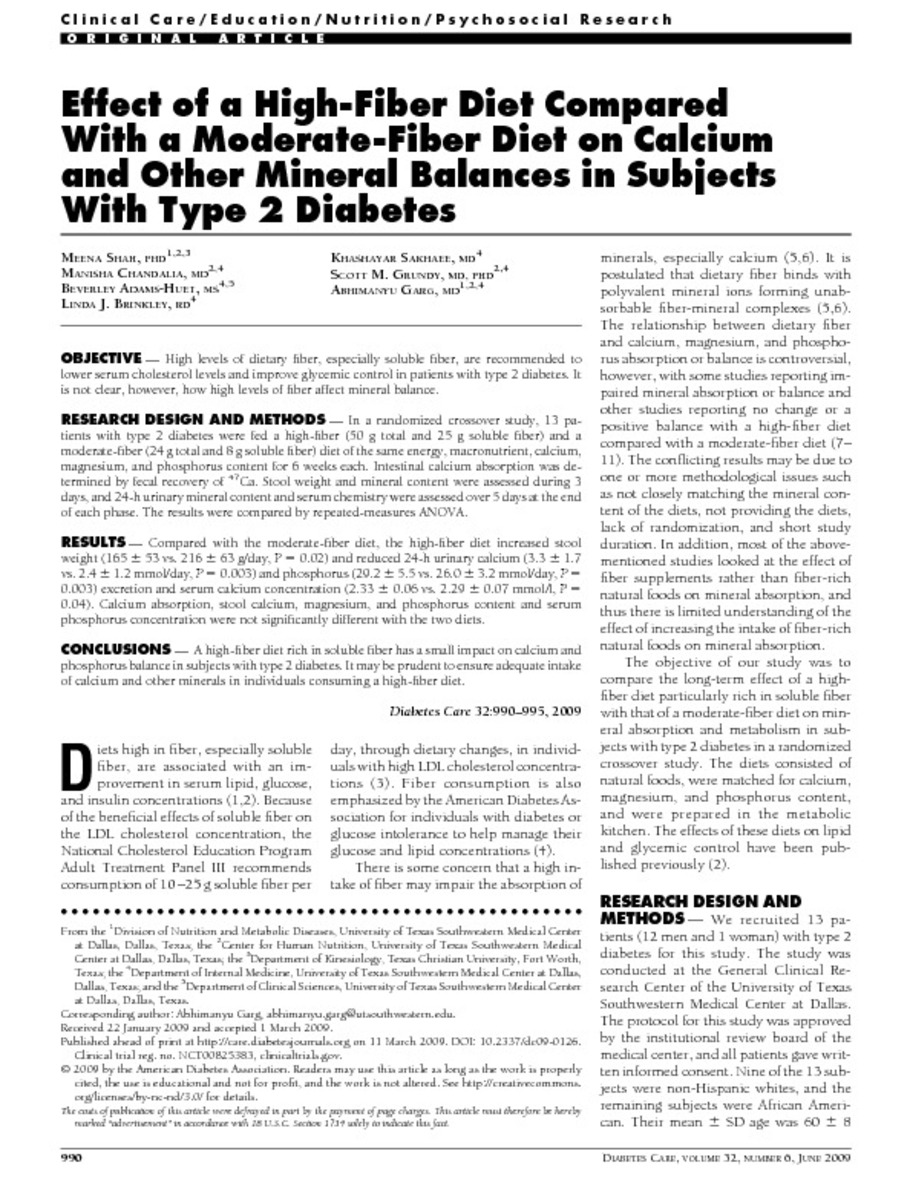Effect of a High-Fiber Diet Compared With a Moderate-Fiber Diet on Calcium and Other Mineral Balances in Subjects With Type 2 DiabetesShow full item record
| Title | Effect of a High-Fiber Diet Compared With a Moderate-Fiber Diet on Calcium and Other Mineral Balances in Subjects With Type 2 Diabetes |
|---|---|
| Author | Shah, Meena; Chandalia, Manisha; Adams-Huet, Beverley; Brinkley, Linda J.; Sakhaee, Khashayar; Grundy, Scott M.; Garg, Abhimanyu |
| Date | 2009-06-01 |
| Abstract | Objective: High levels of dietary fiber, especially soluble fiber, are recommended to lower serum cholesterol levels and improve glycemic control in patients with type 2 diabetes. It is not clear, however, how high levels of fiber affect mineral balance. Research Design and Methods: In a randomized crossover study, 13 patients with type 2 diabetes were fed a high-fiber (50 g total and 25 g soluble fiber) and a moderate-fiber (24 g total and 8 g soluble fiber) diet of the same energy, macronutrient, calcium, magnesium, and phosphorus content for 6 weeks each. Intestinal calcium absorption was determined by fecal recovery of 47Ca. Stool weight and mineral content were assessed during 3 days, and 24-h urinary mineral content and serum chemistry were assessed over 5 days at the end of each phase. The results were compared by repeated-measures ANOVA. Results: Compared with the moderate-fiber diet, the high-fiber diet increased stool weight (165±53 vs. 216±63 g/day, P=0.02) and reduced 24-h urinary calcium (3.3±1.7 vs. 2.4±1.2 mmol/day, P=0.003) and phosphorus (29.2±5.5 vs. 26.0±3.2 mmol/day, P=0.003) excretion and serum calcium concentration (2.33±0.06 vs. 2.29±0.07 mmol/l, P=0.04). Calcium absorption, stool calcium, magnesium, and phosphorus content and serum phosphorus concentration were not significantly different with the two diets. Conclusions: A high-fiber diet rich in soluble fiber has a small impact on calcium and phosphorus balance in subjects with type 2 diabetes. It may be prudent to ensure adequate intake of calcium and other minerals in individuals consuming a high-fiber diet. Diets high in fiber, especially soluble fiber, are associated with an improvement in serum lipid, glucose, and insulin concentrations (1,2). Because of the beneficial effects of soluble fiber on the LDL cholesterol concentration, the National Cholesterol Education Program Adult Treatment Panel III recommends consumption of 10-25 g soluble fiber per day, through dietary changes, in individuals with high LDL cholesterol concentrations (3). Fiber consumption is also emphasized by the American Diabetes Association for individuals with diabetes or glucose intolerance to help manage their glucose and lipid concentrations (4). There is some concern that a high intake of fiber may impair the absorption of minerals, especially calcium (5,6). It is postulated that dietary fiber binds with polyvalent mineral ions forming unabsorbable fiber-mineral complexes (5,6). The relationship between dietary fiber and calcium, magnesium, and phosphorus absorption or balance is controversial, however, with some studies reporting impaired mineral absorption or balance and other studies reporting no change or a positive balance with a high-fiber diet compared with a moderate-fiber diet (7-11). The conflicting results may be due to one or more methodological issues such as not closely matching the mineral content of the diets, not providing the diets, lack of randomization, and short study duration. In addition, most of the above-mentioned studies looked at the effect of fiber supplements rather than fiber-rich natural foods on mineral absorption, and thus there is limited understanding of the effect of increasing the intake of fiber-rich natural foods on mineral absorption. The objective of our study was to compare the long-term effect of a high-fiber diet particularly rich in soluble fiber with that of a moderate-fiber diet on mineral absorption and metabolism in subjects with type 2 diabetes in a randomized crossover study. The diets consisted of natural foods, were matched for calcium, magnesium, and phosphorus content, and were prepared in the metabolic kitchen. The effects of these diets on lipid and glycemic control have been published previously (2). |
| Link | https://doi.org/10.2337/dc09-0126
https://repository.tcu.edu/handle/116099117/19946 https://care.diabetesjournals.org/content/32/6/990 |
| Department | Kinesiology |
| Subject | magnesium
absorption zinc supplementation mechanism phytate bran iron bone |
Files in this item
This item appears in the following Collection(s)
- Research Publications [1008]
© TCU Library 2015 | Contact Special Collections |
HTML Sitemap




